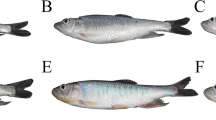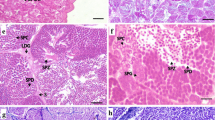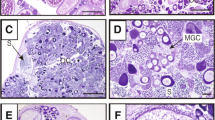Abstract
Sex change was induced in Epinephelus marginatus juveniles using a nonsteroidal aromatase inhibitor (AI), a synthetic androgen (17α-methyltestosterone; MT), and a combination of both (MT + AI) in a 90-day experiment. A detailed remodeling of the gonads, the plasma level of gonadal steroids, and immunostaining of pituitary follicle-stimulating hormone (FSH), luteinizing hormone (LH), and somatolactin (SL) cells were analyzed. Sex inversion reached the final spermatogenesis stages using MT, while AI triggered spermatogenesis, but reaching only the spermatid stage. Estradiol (E2) levels did not change in fish treated with AI but decreased throughout the experimental period in animals treated with MT and MT + AI. Testosterone (T) levels increased in animals treated with MT during the first 60 days (and combined with AI in the first 30 days), decreasing in all experimental groups at 90 days, while AI-treated animals had increased plasma 11-ketotestosterone (11-KT) levels after 90 days. In control fish, FSH- and SL-producing cells (ir-FSH and ir-SL) were restricted to pars intermedia (PI) of the adenohypophysis. Pituitary ir-FSH cells were decreased at the end of the experimental period in all treatments compared with the CT animals. LH-producing cells (ir-LH) were present in proximal pars distalis (PPD) and pars intermedia (PI) of adenohypophysis and did not change after the experimental period. The decreased number of ir-FSH cells at the end of the experiment in all treatments could be related to the negative feedback loop triggered by the increase in natural and/or synthetic androgens.










Similar content being viewed by others
References
Alam MA, Bhandari RK, Kobayashi Y, Soyano K, Nakamura M (2006) Induction of sex change within two full moons during breeding season and spawning in grouper. Aquaculture 255:532–535
Andrade AB, Machado LF, Hostim-Silva M, Barreiros JP (2003) Reproductive biology of the dusky grouper Epinephelus marginatus (LOWE, 1834). Braz Arch Biol Technol 46:373–381
Araújo BA, Wade NW, Mello PH, Rodrigues-Filho JA, Garcia CEO, Campos MF, Botwright NA, Hashimoto DT, Moreira RG (2018) Characterization of lipid metabolism genes and the influence of fatty acid supplementation in the hepatic lipid metabolism of dusky grouper (Epinephelus marginatus). Comp Biochem Physiol A-Mol Integ Physiol 219-220:1–9
Barreiros JP (1998) Sexual inversion in Epinephelus marginatus (Lowe, 1834) (Pisces: Serranidae, Epinephelinae) nos Açores. Rev Portug de Zootec 5:81–90
Besseau L, Bruslé-Sicard S. (1991) Sex inversion in a prontandric hermaphodite Lithgnathus mormayrus (L., 1758) (Teleostei, Sparidae): histocytological peculiarities. In: International Symposium on The Reproductive Physiology of Fish, 4, Sheffield. Proceedings. Sheffield: Fish, 95
Bhandari RK, Komuro H, Nakamura S, Higa M, Nakamura M (2003) Gonadal restructuring and correlative steroid hormone profiles during natural sex change in protogynous honeycomb grouper (Epinephelus merra). Zoolog Scie 20:1399–1404
Bhandari RK, Komuro H, Mikihiko H, Massaru N (2004) Sex inversion of sexually immature honeycomb grouper (Epinephelus merra) by aromatase inhibitor. Zoolog Scie 21:305–310
Cabrita E, Engrola S, Conceição LEC, Pousão-Ferreira P, Dinis MT (2009) Successful cryopreservation of sperm from sex-reversed dusky grouper, Epinephelus marginatus. Aquaculture 287:152–157
Cunha ME, Ré P, Quental-Ferreira H, Gavaia PJ, Pousão-Ferreira P (2013) Larval and juvenile development of dusky grouper Epinephelus marginatus reared in mesocosms. J Fish Biol 83:1–18
Devlin RH, Nagahama Y (2002) Sex determination and sex differentiation in fish: an overview of genetic, physiological, and environmental influences. Aquaculture 208:191–364
Eschmeyer, WN and Fong, JD (2018) Catalog of Fishes. http://researcharchive.calacademy.org/research/ichthyology/catalog/SpeciesByFamily.asp#Serranidae
Garcia CEO, Mello PH, Araújo BC, Narcizo AM, Rodrigues-Filho JA, Medrado AT, Zampieri RA, Floeter-Winter LM, Moreira RG (2013) Involvement of pituitary gonadotropins, gonadal steroids and breeding season in sex-change of protogynous dusky grouper, Epinephelus marginatus (Teleostei: Serranidae), induced by a non-steroidal aromatase inhibitor. Gen Comp Endocrinol 192:170–180
Grier HJ, Taylor RG (1998) Testicular maturation and regression in the common snook. J Fish Biol 53:521–542
Grier HJ, Uribe MC (2009) The testis and spermatogenesis in teleosts. In: Jamieson, BJM (Ed): Reproductive biology and phylogeny of fishes (agnathans and bony fishes) phylogeny reproductive system viviparity spermatozoa, 802
Grier HJ, Uribe MC, Patiño R (2009) The ovary, folliculogenesis and oogenesis in teleosts. In Jamieson, B.J.M (Ed): Reproductive biology and phylogeny of fishes (agnathans and bony fishes) phylogeny reproductive system viviparity spermatozoa, 802
Guiguen Y, Fostier A, Piferrer F, Chang CF (2010) Ovarian aromatase and estrogens: a pivotal role for gonadal sex differentiation and sex change in fish. Gen Comp Endocrinol 165:352–366
Heemstra PC, Randall JE (1993) FAO species catalogue. Groupers of the world (Family Serranidae, Subfamily Epinephelinae). FAO, Rome 16: 382
IUCN (2019) The IUCN Red List of Threatened Species. Version 2019-2. <www.iucnredlist.org>. Downloaded on 08 September 2019
Kobayashi Y, Alam MA, Horiguchi R, Shimizu A, Nakamura M (2010) Sexually dimorphic expression of gonadotropin subunits in the pituitary of protogynous honeycomb grouper (Epinephelus merra): evidence that follicle-stimulating hormone (FSH) induces gonadal sex change. Biol of Reprod 82(6):1030–1036
Levavi-Sivan B, Bogerd J, Mañanós EL, Gómez A, Lareyre JJ (2010) Perspectives on fish gonadotropins and their receptors. Gen Comp Endocrinol 165:412–437
Li CJ, Zhou L, Wang Y, Hong YH, Gui JF (2005) Molecular and expression characterization of three gonadotropin subunits common α, FSHß and LHß in groupers. Mol Cel Endocrinol 233:33–46
Lokman PM, Wylie MJ, Downes M, Di Biase A, Damsteegt EL (2015) Artificial induction of maturation in female silver eels, Anguilla australis: the benefits of androgen pre-treatment. Aquaculture 437:111–119
Lubzens E, Young G, Cerda J (2010) Oogenesis in teleosts: how eggs are formed. Gen Comp Endocrinol 165:367–389
Marino G, Azzurro E, Finoia MG, Messina MT, Massari A, Mandich A (2000) Recent advances in induced breeding of the dusky grouper Epinephelus marginatus (Lowe, 1834). Ciheam Options Mediterraneennes 47:215–225
Marino G, Di Marco P, Massari A, Bottero S, Mandich A (2002) Effects of temperature and social control on sexual maturity and sex inversion in captive dusky grouper Epinephelus marginatus. In Proceedings of the International Conference of Aquaculture Europe (Basurco, B. & Saroglia, M., eds), pp. 331–332
Marino G, Panini E, Longobardi A, Mandich A, Finoia MG, Zohar Y, Mylonas CC (2003) Induction of ovulation in captive-reared dusky grouper, Epinephelus marginatus (Lowe, 1834) with a sustained-release GnRHa implant. Aquaculture 219:841–858
Mazzoni T, Lo Nostro F, Antoneli F, Quagio-Grassiotto I (2018) Action of the metalloproteinases in gonadal remodeling during sex reversal in the sequential hermaphroditism of the teleostei fish Synbranchus marmoratus (Synbranchiformes: Synbranchidae). Cells 7:34
Mello PH, Araújo BC, Campos MF, Rodrigues-Filho JA, Garcia CEO, Moreira RG (2018) Embryonic and larval development and fatty acid profile of the dusky grouper (Epinephelus marginatus) reproduced in captivity: tools applied to captive rearing. J Fish Biol 92:1126–1148
Miura T, Miura CI (2003) Molecular control mechanisms of fish spermatogenesis. Fish Physiol and Biochem 28:181–186
Reñones O, Grau A, Mas X, Riera F, Saborido-Rey F (2010) Reproductive pattern of an exploited dusky grouper Epinephelus marginatus (Lowe 1834) (Pisces: Serranidae) population in the western Mediterranean. Sci Mar 74:523–537
Rodrigues-Filho JA, Sanches EG, Garcia CEO, Pannuti CV, Sebastiani EF, Moreira RG (2009) Threatened fishes of the world: Epinephelus marginatus (Lowe, 1834) (Serranidae: Epinephelinae). Environ Biol of Fish 85:301–302
Russo T, Boglione C, De Marzi P, Cataudella S (2009) Feeding preferences of the dusky grouper (Epinephelus marginatus, Lowe 1834) larvae reared in semi-intensive conditions: a contribution addressing the domestication of this species. Aquaculture 289:289–296
Sadovy Y, Shapiro DY (1987) Criteria for the diagnosis of hermaphroditism in fishes. Copeia 1:136–156
Sanches EG, Oliveira IR, Serralheiro PCS (2009) Inversão sexual da garoupa-verdadeira Epinephelus marginatus. R Bras Saúde e Produt 10:198–209
Sarter K, Papadaki M, Zanuy S, Mylonas C (2006) Permanent sex inversion in 1-year –old juveniles of the protogynous dusky grouper (Epinephelus marginatus) using controlled-release 17α-methyltestosterone implants. Aquaculture 256:443–456
Schulz RW, França LR, Lareyre JJ, Legac F, Chiarini-Garcia H, Nobrega RH, Miura T (2010) Spermatogenesis in fish. Gen Comp Endocrinol 165:390–411
Slater CH, Schreck CB, Swanson P (1994) Plasma profiles of the sex steroids and gonadotropins in maturing female spring chinook salmon Oncorhynchus tshawytscha. Comp Biochem Physiol A-Mol Integ Physiol 109:167–175
Spedicato MT, Lembo G, Di Marco P, Marino G (1995) Preliminary results in the breeding of dusky grouper Epinephelus marginatus (Lowe, 1834). Cah Options Méditerr 16:131–148
Swanson P, Suzuki K, Kawauchi H, Dickhoff WW (1991) Isolation and characterization of two coho salmon gonadotropins, GTH I and GTH II. Biology Reproduction 44:29–38
Vaini JO, Mota KG, Ojeda AP, Barreiros JP, Moreira RG, Hilsdorf AWS (2019) Development and characterization of 20 polymorphic microsatellite markers for Epinephelus marginatus (Lowe, 1834) (Perciformes: Epinephelidae) using 454 pyrosequencing. Genet Mol Biol 42(1):74–79. https://doi.org/10.1590/1678-4685-gmb-2018-0067
Wang Q, Liu Y, Peng C, Wang X, Xiao L, Wang D, Chen J, Zhang H, Zhao H, Li SS, Zhang Y, Lin H (2017) Molecular regulation of sex change induced by methyltestosterone-feeding and methyltestosterone-feeding withdrawal in the protogynous orange-spotted grouper. Biol Reprod 97:324–333
Wu GC, Li HW, Tey WG, Lin CJ, Chang CF (2017) Expression profile of amh/Amh during bidirectional sex change in the protogynous orange-spotted grouper Epinephelus coioides. Plos One 12(10):1–18
Yaron Z, Gur G, Melamed P, Rosenfeld H, Elizur A, Levavi-Sivan B (2003) Regulation of fish gonadotropins. Int Rev Cytol 225:131–185
Acknowledgments
The authors would like to thank Instituto de Pesca (Ubatuba/SP) that provided the logistics and facilities for the experiment, Dr. Irani Quagio-Grassiotto (UNESP) for her contribution in gonadal histological analysis, and Dr. H. Kawauchi (School of Fisheries Sciences, Kitasato University, Japan) for donating βLH, βFSH, and SL antisera from chum salmon.
Funding
This study was financially supported by a research grant from FAPESP (2007/59122-7) and CNPq (558992/2009-9). J.A.Rodrigues-Filho also had a FAPESP scholarship (2007/57106-4).
Author information
Authors and Affiliations
Corresponding author
Ethics declarations
All experiments were performed in accordance with the Animal Ethics Committee of the Biosciences Institute of the University of São Paulo (Protocol No. 055/2008). This license was based in the guidelines of the Brazilian Federal Law (11.794, of 10/08/2008), which establishes the procedures for the scientific use of animals, and the São Paulo State Law (11.977, of 08/25/2005), which establishes the Animal Protection Code of the State of São Paulo and other rules applicable to the use of animals for teaching and scientific purposes.
Conflict of interest
The authors declare that they have no conflict of interest.
Additional information
Publisher’s note
Springer Nature remains neutral with regard to jurisdictional claims in published maps and institutional affiliations.
Rights and permissions
About this article
Cite this article
Rodrigues-Filho, J.A., Garcia, C.E.O., Chehade, C.G. et al. Gonadal remodeling and hormonal regulation during sex change of juvenile dusky grouper Epinephelus marginatus (Teleostei, Serranidae), an endangered protogynous hermaphrodite fish. Fish Physiol Biochem 46, 1809–1824 (2020). https://doi.org/10.1007/s10695-020-00830-8
Received:
Accepted:
Published:
Issue Date:
DOI: https://doi.org/10.1007/s10695-020-00830-8




